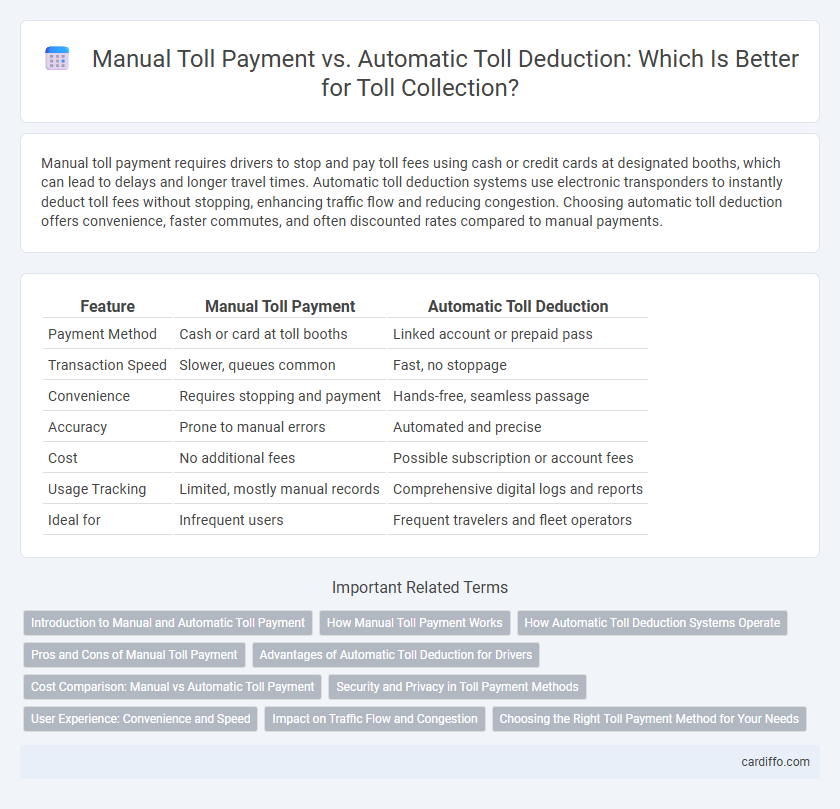Manual toll payment requires drivers to stop and pay toll fees using cash or credit cards at designated booths, which can lead to delays and longer travel times. Automatic toll deduction systems use electronic transponders to instantly deduct toll fees without stopping, enhancing traffic flow and reducing congestion. Choosing automatic toll deduction offers convenience, faster commutes, and often discounted rates compared to manual payments.
Table of Comparison
| Feature | Manual Toll Payment | Automatic Toll Deduction |
|---|---|---|
| Payment Method | Cash or card at toll booths | Linked account or prepaid pass |
| Transaction Speed | Slower, queues common | Fast, no stoppage |
| Convenience | Requires stopping and payment | Hands-free, seamless passage |
| Accuracy | Prone to manual errors | Automated and precise |
| Cost | No additional fees | Possible subscription or account fees |
| Usage Tracking | Limited, mostly manual records | Comprehensive digital logs and reports |
| Ideal for | Infrequent users | Frequent travelers and fleet operators |
Introduction to Manual and Automatic Toll Payment
Manual toll payment requires drivers to stop at toll booths and pay using cash or cards, often causing delays during peak hours. Automatic toll deduction employs electronic toll collection systems, such as RFID tags or transponders, allowing seamless passage without stopping. This technology enhances traffic flow, reduces congestion, and improves overall travel efficiency on toll roads.
How Manual Toll Payment Works
Manual toll payment involves drivers stopping at toll booths to pay fees using cash or card before proceeding. This process requires toll operators or automated machines to verify payments and raise barriers for passing vehicles. Although time-consuming compared to automatic toll deduction, manual payment ensures accessibility for drivers without electronic toll tags or digital accounts.
How Automatic Toll Deduction Systems Operate
Automatic toll deduction systems operate using RFID technology or electronic transponders linked to users' prepaid or postpaid accounts, enabling vehicles to pass toll booths without stopping. These systems capture vehicle identification information through sensors, instantly deducting the toll fee from the associated account while maintaining traffic flow efficiency. Real-time data processing ensures accurate billing and reduces congestion compared to manual toll payment methods.
Pros and Cons of Manual Toll Payment
Manual toll payment provides flexibility by allowing drivers to pay with cash or cards without requiring electronic devices, making it accessible to all vehicle types. However, it often leads to longer wait times and traffic congestion at toll booths compared to automatic toll deduction systems. The manual process also increases the risk of human error and requires toll operators for cash handling and change distribution.
Advantages of Automatic Toll Deduction for Drivers
Automatic toll deduction offers drivers significant time savings by eliminating the need to stop and manually pay at toll booths, ensuring smoother and faster travel. This system reduces traffic congestion and lowers fuel consumption due to continuous vehicle movement. Enhanced convenience and seamless integration with electronic payment methods also contribute to improved road safety and driver satisfaction.
Cost Comparison: Manual vs Automatic Toll Payment
Manual toll payment often involves higher transaction costs due to cash handling, slower processing times, and occasional fees imposed by toll operators. Automatic toll deduction systems, such as electronic toll collection (ETC), reduce operational expenses by enabling seamless payments with lower administrative overhead and fewer delays. Cost efficiency in automatic toll deduction translates to savings for both drivers and toll authorities, making it a financially preferable option over manual payment methods.
Security and Privacy in Toll Payment Methods
Manual toll payment offers increased control over personal data as users provide payment details directly at the toll booth, reducing the risk of digital data breaches. Automatic toll deduction systems, often linked to electronic toll collection tags or license plate recognition, enhance convenience but may raise concerns about continuous location tracking and unauthorized data sharing. Selecting a toll payment method requires balancing the convenience of automatic payments with the enhanced data privacy and security afforded by manual transactions.
User Experience: Convenience and Speed
Manual toll payment requires stopping at toll booths, leading to delays and increased travel time, while automatic toll deduction uses electronic tags or license plate recognition to enable seamless passage without stopping. Automatic toll systems enhance user experience by reducing congestion and minimizing errors, providing a faster and more convenient journey. The convenience of automatic toll deduction improves overall traffic flow and reduces driver stress compared to manual payment methods.
Impact on Traffic Flow and Congestion
Manual toll payment significantly slows traffic flow by requiring vehicles to stop or slow down at toll booths, causing congestion and longer wait times during peak hours. Automatic toll deduction systems use electronic transponders or license plate recognition to process payments at highway speeds, reducing bottlenecks and maintaining smoother traffic movement. Implementing automatic toll collection can decrease traffic delays by up to 30%, improving overall roadway efficiency and reducing emissions related to idling.
Choosing the Right Toll Payment Method for Your Needs
Selecting the right toll payment method depends on factors such as travel frequency, convenience, and transaction speed. Manual toll payment requires cash or card at toll booths, which may cause delays during peak hours. Automatic toll deduction systems, using RFID or transponders linked to prepaid accounts, offer seamless passage and often provide discounted rates for frequent commuters.
Manual Toll Payment vs Automatic Toll Deduction Infographic

 cardiffo.com
cardiffo.com